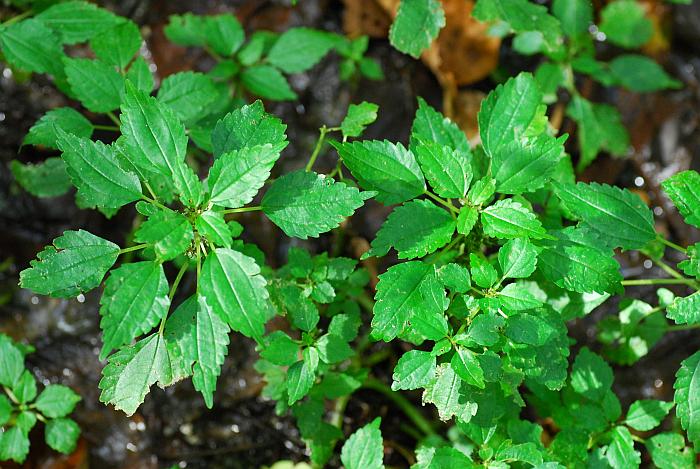Pilea fontana (Lunell) Rydb.
Lesser Clearweed

Native
CC =
CW =
MOC = 1
© SRTurner
Pilea fontana (Lunell) Rydb.Lesser Clearweed | |
 |
Native CC = CW = MOC = 1 |
© SRTurner |
|
Family - Urticaceae Habit - Annual taprooted forb, monoecious or dioecious, unarmed, glabrous, the stems and leaf petioles translucent. Stem - To 50 cm, erect or ascending, occasionally from a spreading base, usually unbranched, stout, glabrous, translucent, and slightly succulent.
Leaves - Opposite, long-petiolate, stipulate. Blades 2-12 cm long, elliptic to ovate, broadly angled to rounded at the base, tapered at the tip, the margins bluntly toothed to nearly scalloped or occasionally sharply toothed, with 3 main veins.
Inflorescences - Small axillary clusters, these often arranged into small panicles, the staminate and pistillate flowers usually on different branches of the same panicle. Bractlets not forming an involucre. Flowers - Staminate flowers with 4 sepals, these 0.7-1.1 mm long, loosely cupped around the stamens. Stamens 4. Pistillate flowers with 3 free sepals, these 0.8-1.2 mm long, equal or occasionally 1 somewhat enlarged and hoodlike. Style absent, the stigma capitate, not persistent at fruiting. Fruits - 1.3-1.8 mm long, flattened, ovate in outline, the surfaces irregular and tuberculate, dark purple to nearly black.
Flowering - July - October. Habitat - Fens, very wet soils. Origin - Native to the U.S. Lookalikes - Pilea pumila; more broadly, other members of the Urticaceae such as Urtica dioica and Boehmeria cylindrica. Other info. - This species was first discovered in Missouri by Aaron Floden and Meg Englehardt in August 2019, growing in a fen in Lafayette County. The species is much less common than its sibling P. pumila, occurring in scattered locations in the upper Midwest and along the eastern U.S. coast. The occurrence in Lafayette County is considerably disjunct from previously known populations, and the plant should be searched for in other Missouri locations, particularly toward the northern portions of the state. Photographs taken at Hicklin Fen, Lafayette County, MO, 10-1-2019 (SRTurner). |